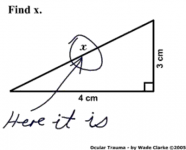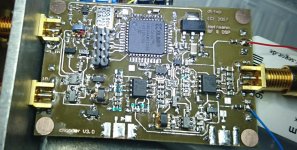Hi Richard,
Well, for starters you could measure RIAA networks or any other filter network. If you want to scare yourself, measure a first generation CD output filter! It would also be good for tuner filters at 19 and 38 KHz.
I imagine it would also measure the response of small signal amplifiers quite well.
The question is Richard, what do you want to measure with that instrument?
-Chris
Holy crap!An HP 4192A Impedance analyzer just dropped into my lap.... what should I measure re. audio?
Well, for starters you could measure RIAA networks or any other filter network. If you want to scare yourself, measure a first generation CD output filter! It would also be good for tuner filters at 19 and 38 KHz.
I imagine it would also measure the response of small signal amplifiers quite well.
The question is Richard, what do you want to measure with that instrument?
-Chris
Hi John,
-Chris
That's what all the advertisers sold to the general population. Most are not technical, so what do you expect? Why do you think that the average person isn't nearly interested in audio like they were in the 70's before the really big lies hit?It never ceases to amaze me that people think that CD can ever be 'perfect sound forever'
-Chris
Jan, where have you found 'Daniel Herz Levinson'? Can you pls provide a link?
Fake news I say
Harman Kardon is discontinuing the Mark Levinson brand
Fake news I say
Last edited:
I think Jan was having a senior moment and meaning to post that in this thread
Daniel Hertz Levinson M1 wow
Daniel Hertz Levinson M1 wow
I narrowly missed an HP 3589A network analyzer. 🙁
That would have been a nice instrument to have. I have several similar types. Most of my electronics involved either high energy pulsed power or RF and microwaves. So, I still have a HP 8753D. Went to HP school on it and others'.
I got it cheap enough from eBay because it didn't work. With schematic, it was found to be a problem on the mother board for the front panel and was fixed easily...... $$$ dollars saved.
THx-Richard
Last edited:
The 8753D is a Vector network Analyzer for 100 KHz to 3GHz (75 Ohm or 6 GHz for some 50 Ohm versions) with a built in test set usually (I have one here as well). The cables and fixtures to get it working usefully can cost as much as a used HP 4192.
The 4192A looks really interesting. The Bode 100 analyzer does very similar testing OMICRON Lab "Smart Measurement Solutions": Product Description using a lot less bench space. it may not have as much resolution. Jan has one I think. I have access to one when I need as well.
The 4192A looks really interesting. The Bode 100 analyzer does very similar testing OMICRON Lab "Smart Measurement Solutions": Product Description using a lot less bench space. it may not have as much resolution. Jan has one I think. I have access to one when I need as well.
The 8753D is a Vector network Analyzer for 100 KHz to 3GHz (75 Ohm or 6 GHz for some 50 Ohm versions) with a built in test set usually (I have one here as well). The cables and fixtures to get it working usefully can cost as much as a used HP 4192.
Mine is only for my RF work, of course. Now, an FM broadcast transmitter project. And yes, I have the cables and cal set. new precision cables run about 1000 dollars a meter. APC -7 type. 30MHz to 6 GHz. Color display.
But my favorites for audio are Anritsu MS____ series. I have 2 dual channel for 10Hz to 30MHz. One is in Bangkok. Both HP and Anritsu can be had with high Z probes.
The HP 4192A is a nice compliment to the network analyzers and is high Z. ( 1 Meg) and can take 2 v rms +/- 35vdc on input. Easy to extend input max.
THx-RNMarsh
Last edited:
I think Jan was having a senior moment and meaning to post that in this thread
Daniel Hertz Levinson M1 wow
Yes that was the post that led me to it, but Mark is stirring the pot again. Like here:
Daniel Hertz and Mark Levinson's Major Statement | Stereophile.com
HOME
@Dimitri: wasn't HK discontinuing the 'luxury brand' audio brands?
Mark hasn't lost his touch and moved with the times, witness:
"It seems I may also have heard the Daniel Hertz "Master Class" app ($660), which the PR touts as "the ultimate music player software for Apple computers... [a] revolutionary development in quality audio [that] lets any music lover take average sounding CDs or downloads and turn them into audiophile recordings." "Master Class," I was told "combines the EQ of the legendary Cello Audio Palette with 'A+,' a new technology for enhancing the transparency of PCM digital audio. With 'Master Class,' most music CDs and downloads can be made to sound and feel like analog or pure Direct Stream Digital (DSD)."
Read more at https://www.stereophile.com/content/daniel-hertz-and-mark-levinsons-major-statement#mFFweFLi8s0CLs3F.99"
Bold mine. Take note, JC! ;-)
Jan
Last edited:
The 8753D is a Vector network Analyzer for 100 KHz to 3GHz (75 Ohm or 6 GHz for some 50 Ohm versions) with a built in test set usually (I have one here as well). The cables and fixtures to get it working usefully can cost as much as a used HP 4192.
The 4192A looks really interesting. The Bode 100 analyzer does very similar testing OMICRON Lab "Smart Measurement Solutions": Product Description using a lot less bench space. it may not have as much resolution. Jan has one I think. I have access to one when I need as well.
The Bode 100 has a bit more than 100dB dynamic range iirc. Depends on the receiver bandwidth. At 1Hz, the narrowest, it is very clean but measurements take longer of course.
Jan
An HP 4192A Impedance analyzer just dropped into my lap.... what should I measure re. audio?
-RNM
That reminds me of the story of the student getting fed up with the obligatory stupid questions in the physics exams.
When he got to this question: "You have a barometer. How can you find the height of a building with it?" he decided to fight back. His answer:
"I will climb to the roof and drop the barometer over the edge. I will time the duration of the fall and using the equation for acceleration under gravity I will calculate the building height".
His professor called him in and said that this was not what he expected and could he give it another shot?
"Sure. I will go out on a sunny day and measure the barometer height and shadow length. I will also measure the shadow length of the building and from the ratios calculate the building height".
"Sorry, still not what I expect. Anything else?"
"Sure. I will climb the stairs in the building marking off barometer heights on the wall with a pencil. When I multiply the number of mark-offs with the barometer height I have the building height".
"Last chance!"
"OK then. I will look up the building concierge and tell him: 'my good man, I here have a nice barometer. If you pray tell me the height of this building, it is yours'".
He passed.
Jan
I first heard that joke in 1986 in Oxford, but then it was a physicist, a mathematician and and engineer trying to work out the height of a tower! Clearly it has several versions 🙂
😀
I believe I read it in a book by Richard Feynman illustrating 'thinking out of the box'.
Jan
Yes that was the post that led me to it, but Mark is stirring the pot again. Like here:
Daniel Hertz and Mark Levinson's Major Statement | Stereophile.com
Jan
Ahh. I see. Odd that I can't seem to find any reviews of this stuff.
Following on from your comment yesterday about the availability of low Rbb bipolars with low 1/f knee,I thought it might be a good time to offend the high voltage folded cascode mob with this blast from the past. This is Richard Lee's improved Leach MC headamp from 1981
A Flat Moving Coil Preamp Using Paralleled Amplifiers - Page 4 - Pro Audio Design Forum
I would copy the schematic but don't want to upset Richard and lots of good stuff over on Wayne's forum for people with an open mind so worth a visit 🙂
It's not universal, but for the right MC this is a deliciously simple way to get 30dB of low noise gain. Singe 1.5v battery per channel and fits in the ubiquitous altoids tin.
Richard is it the amp?
Damir
Following on from your comment yesterday about the availability of low Rbb bipolars with low 1/f knee,I thought it might be a good time to offend the high voltage folded cascode mob with this blast from the past. This is Richard Lee's improved Leach MC headamp from 1981
That paralleling of low Rbb transistors was already in the PMI databook under MAT-02.
I think the 1985 MAT-02s that I have are already made by AD. My old PMI data book is
200 miles away from here.
But it also works with CMOS. 😀 I get abt. 300pV rt Hz with still unoptimzed transformer
and post amp and without any paralleling. Below 10 Hz the Agilent 89441A drowns
everything in its own 1/f noise, I clearly need a better FFT analyzer.
It was fun to wind the input transformer under the microscope.
It is a transposed gain amplifier @ 1MHz. Input is differential and galvanically
isolated from the rest of the amplifier. Energy for the chopper is transferred via
the clock transformer @ 1MHz.
I have ordered a RedPitaya, but that will need some software / firmware mods.
Attachments
Last edited:
But 0.28nV/rtHz* from a single complementary pair is more than enough for all but the most pathological MC cartridges. At least until I score a ribbon cartridge...
Any pics of the transformer? or are they the tiny bits on the LHS of the picture?
*The Zetex devices should be a gnatfart lower but until someone builds it we don't know.
Any pics of the transformer? or are they the tiny bits on the LHS of the picture?
*The Zetex devices should be a gnatfart lower but until someone builds it we don't know.
- Status
- Not open for further replies.
- Home
- Member Areas
- The Lounge
- John Curl's Blowtorch preamplifier part II
![25579056_1652515468125382_1974128545_o[1].jpg 25579056_1652515468125382_1974128545_o[1].jpg](https://www.diyaudio.com/community/data/attachments/595/595397-a94ae435e9c58bf36554fe872cf02914.jpg?hash=qUrkNenFi_)

